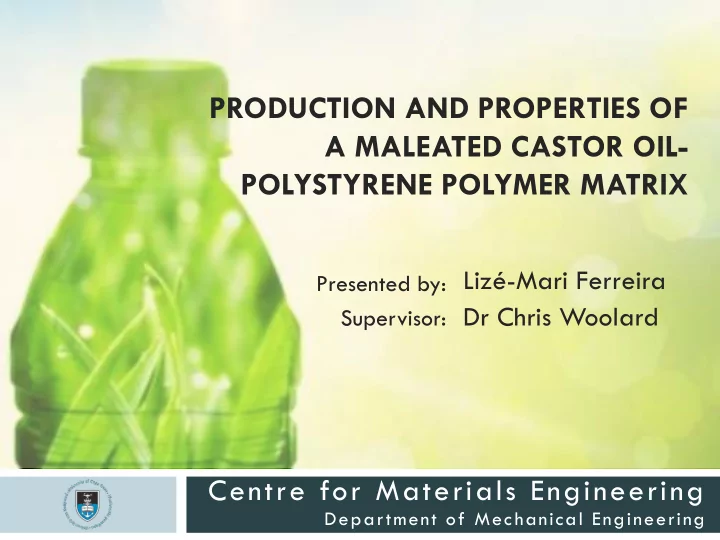

PRODUCTION AND PROPERTIES OF A MALEATED CASTOR OIL- POLYSTYRENE POLYMER MATRIX Lizé-Mari Ferreira Presented by: Dr Chris Woolard Supervisor: Centre for Materials Engineering Department of Mechanical Engineering
OUTLINE • Introduction to study • Aim of the study • Overview on synthesis of matrix and composite • Mechanical tests and results • Fracture surface analysis • SEM (RISE) • Raman Confocal Microscopy • TEM • Conclusions
INTRODUCTION TO STUDY https://images.squarespace-cdn.com/content/v1/558f1c27e4b0927589e0edad/1558138099808- https://www.newdelhitimes.com/wp-content/uploads/2018/05/ GLR0Z38K30FCAUTTF2AU/ke17ZwdGBToddI8pDm48kIkgHTxUnlW7VysxtwKs7v57gQa3H78H3Y0t shutterstock_604150523-e1527312859846.jpg xjaiv_0fDoOvxcdMmMKkDsyUqMSsMWxHk725yiiHCCLfrh8O1z4YTzHvnKhyp6Da- NYroOW3ZGjoBKy3azqku80C789l0ivq7Q1ckvJa8MA8qNUlEObOCsMVUGH9o4TViecrUGpmccNK 2aHmPI1EqrJ3R2V6NQ/IMG_6693.JPG?format=1500w “…the supplies used to produce products in accordance to the needs of humans should not be depleted; and emissions caused by the production or disposal of products should have no negative impact on the environment…” 1
INTRODUCTION TO STUDY What sets vegetable oil-based polymers apart from conventional polymers? More affordable Natural resources are readily available Properties similar to those of conventional polymers (or better) Some are biodegradable, non-toxic Low contribution to production of greenhouse gasses Why castor oil? Non-edible Contains double bonds and hydroxyl groups = increased reactivity
INTRODUCTION TO STUDY https://www.researchgate.net/publication/276060634_Bioplastics_-_Biobased_plastics_as_renewable_andor_biodegradable_alternatives_to_petroplastics
AIM OF STUDY Conduct research on non-polyurethane biopolymers Develop a maleated castor oil/polystyrene (MACO-PS) polymer matrix Reinforce the matrix with natural fibres Determine the mechanical properties of the matrix as well as the reinforced composite Compare these mechanical properties to those of GPPS (general purpose PS) and HIPS (high impact PS) Measure biodegradability of MACO-PS matrix
SYNTHESIS OF MATRIX 4-step process: 1. Maleation of castor oil 2. Formation of matrix with styrene (MACO-PS) 3. Hand layup process 4. Thermal curing
RESULTS OF MECHANICAL TESTS AND THERMAL ANALYSIS Property MACO-PS GPPS HIPS Reinforced Standard/ MACO-PS Method Flexural Properties UTS (MPa) 22.1 74.4 27.2 12.2 Toughness 3.94 1.12 3.24 > 2.76 ASTM (MPa) D7264-15 Strain at 24.7 % 2.80 % 14.0 % >31.4% break Charpy Impact Test Impact ASTM strength 41.5 33.9 58.4 45.0 D6110 (kJ/m2) Hardness Shore-D 60.5 85.0 76.9 68.0 Durometer hardness
RESULTS OF MECHANICAL TESTS AND THERMAL ANALYSIS Property MACO-PS GPPS HIPS Reinforced Standard/ MACO-PS Method Tensile Properties UTS (MPa) 23 44.8 13.5 13.1 Young’s modulus 1.0 3.3 1.5 0.3 (GPa) ASTM D638-14 Toughness 2.53 0.61 3.19 1.0 (MPa) Strain at 12.8 % 1.60 % 25.8 % 11.8 % break Differential Scanning Calorimetry Tg ( ˚C) 54.9 and -85.2 and Heating rate 90-95 - 93.2 104.3 of 20˚C/min
MICROSCOPY METHODS Fracture surfaces Leica MZ 8 stereomicroscope SEM WiTec RISE electron microscope A Backscatter electron analysis MACOPS Low vacuum in presence of small amount of moisture 20kV acceleration voltage 200x magnification PS HIPS
MICROSCOPY METHODS Raman spectroscopy WiTec Alpha 300R confocal microscope 1-2mW laser power (solids) and 5mW (liquids) Integration time was 1.19s for spectra and 0.25s for maps TEM A MACOPS Samples cut using Leica Reichert Ultracut S with a diamond blade (100nm sample thickness) Samples were vapour stained with 2% OsO 4 solution for 1hr and 16hrs; 0.6% RuO 4 for 30min FEI Tecnai G2 F20 X-Twin transmission electron microscope Operated at 200kV PS HIPS
FRACTURE SURFACES ≈ 4mm A MACO-PS ≈ 4mm PS HIPS ≈ 2mm
FRACTURE SURFACES Voids caused by absence of matrix ≈ 6mm ≈ 6mm
FRACTURE SURFACES Delamination LOAD DIRECTION ≈ 5mm Fibre breaking Delamination Delamination Crazing Fracture surface
SEM A C D B C E
SEM Matrix with imprint left from fibre Fibre
RAMAN MAPPING MACO-PS HIPS
TEM Polybutadiene
TEM 100nm 100nm
CONCLUSIONS The mechanical properties of the green MACO-PS matrix corresponds to those found for HIPS Fracture surfaces found for the tested materials backed the mechanical test results SEM was successfully used to identify the cause for weak mechanical properties of the reinforced composite Raman mapping together with TEM confirmed the morphology of the matrix to be either a random co-polymer or an interpenetrating polymer network
REFERENCES [1] N. Winterton, Chemistry for Sustainable Technologies: A Foundation, Cambridge, UK: RSC Publishing, 2011. [2] F. S. Guner, Y. Yagci and A. T. Erciyes, "Polymers from triglyceride oils," Progress in Polymer Science, vol. 31, pp. 633-670, 2006. [3] E. Mubofu, "Castor oil as a potential renewable resource for the production of functional materials," Sustainable Chemical Processes, vol. 4, no. 11, 2016. [4] V. Patel, G. Dumancas, L. Viswanath, R. Maples and B. Subong, "Castor oil: properties, uses, and optimization of processing parameters in commercial production," Lipid insights, vol. 9, pp. 1-12, 2016. [5] G. Totaro, L. Cruciani, M. Vannini, G. Mazzola, D. Gioia, A. Celli and L. Sisti, "Synthesis of castor oil- derived polyesters with antimicrobial activity," European Polymer Journal, vol. 56, pp. 174-184, 2014. [6] M. Mosiewicki, M. Aranguren and J. Borrajo, "Mechanical Properties of Linseed Oil Monoglyceride Maleate/Styrene Copolymers," Journal of Applied Polymer Science, vol. 97, pp. 825-836, 2005. [7] G. Lampman, D. Pavia, G. Kriz and J. Vyvyan, Spectroscopy, 4th ed., Brooks/Cole Cengage Learning, 2010.
Recommend
More recommend